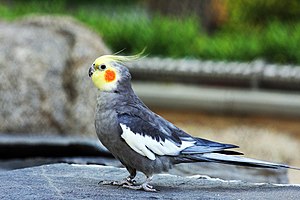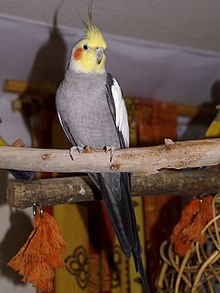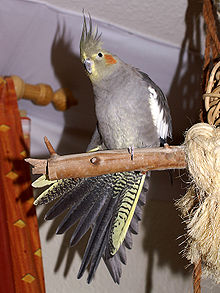Cockatiel
| Cockatiel | ||||||||||
|---|---|---|---|---|---|---|---|---|---|---|

Cockatiel ( Nymphicus hollandicus ), males (stronger colors; females: head more subdued, tail banded underneath - see picture at the bottom) |
||||||||||
| Systematics | ||||||||||
|
||||||||||
| Scientific name of the genus | ||||||||||
| Nymphicus | ||||||||||
| Wagler , 1832 | ||||||||||
| Scientific name of the species | ||||||||||
| Nymphicus hollandicus | ||||||||||
| ( Kerr , 1792) |
The cockatiel ( Nymphicus hollandicus ) is the only species in the genus of the cockatiel ( Nymphicus ). Within ornithology it was long disputed whether the cockatiel belongs to the family of the cockatoos (Cacatuidae) or to the real parrots (Psittacidae) within the order of the parrots (Psittaciformes) and is more closely related to other "parakeet species". (Alternative names such as cockatoo parakeet and wedge-tailed cockatoo indicate these uncertainties in the system). It is now certain that it can be assigned to the cockatoos. However, no other cockatoo differs as much from the other members of the family as the cockatiel, which is why it is placed in its own genus.
Cockatiels are small, slender parrots that inhabit most of the entire Australian continent. They live very nomadically and roam in large parts of their area of distribution. Due to this constant mixing of the population, no recognizable subspecies have developed. Their tail is long and conical. The wings are pointed and almost half the length of the tail. The beak is small compared to the body size. The species shows a conspicuous sexual dimorphism . While males have a yellow mask (face), females only have a slightly yellow or nonexistent mask. Young birds initially resemble the adult female. Both parent birds are involved in the brood and care for the offspring.
Cockatiels are popular and widely used pets . The first wild-caught animals came to Europe around 1840, and ten years later they were successfully bred.
Systematics
The exact systematic classification of the cockatiels within the parrot order has not yet been conclusively clarified. The current scientific name Nymphicus hollandicus has only been used since 1832.

In 1788 Johann Friedrich Gmelin named the cockatiel "Cockatoo" with the Latin name Psittacus novae-hollandiae . The second part of this name represents a designation of origin: The first discoverers of Australia, Dutch seafarers, had called the Australian continent "New Holland", Latin novae-hollandiae . In 1792 the ornithologist Robert Kerr established the current species name hollandicus . The zoologist Johann Georg Wagler established the genus Nymphicus in 1832 . It can no longer be determined today what inspired him to choose this name.
Today the cockatiel is assigned a systematic special position, but in close relation to the cockatoo. The cockatiel is often listed in its own subfamily of cockatoos. The subfamily Nymphicinae only has one genus with Nymphicus . There are various theses about the development history of the cockatiel, but none could be proven. A common, already extinct stem form is assumed. From this both the flat-tailed parakeets and the cockatiels and in the same line the cockatoos could have developed. Meanwhile, the close relationship with the is calyptorhynchus ( Calyptorhynchus ), the helmet cockatoo ( Callocephalon fimbriatum ) and the Rosakakadu ( Eolophus roseicapilla ) were found. The striking color dimorphism between the sexes indicates a close connection to the Black Cockatoo.
Appearance and build
The wild form of the cockatiels reaches a body length of 32 centimeters. The birds weigh between 73 and 102 grams.
The cockatiel's original appearance is gray with white wing-coverts and an orange spot on the cheek. The males have a distinctive yellow face mask. The females have yellow-black transverse bands on the underside of the tail and are generally a little paler than the males. As is characteristic of cockatoos, they have a feather bonnet. The orange ear mark that both sexes have is sharply demarcated in them early on. The young birds resemble the females. Therefore, up to an age of about six months, it is difficult to distinguish between males and females. Only when the yellow feathers on the head become visible after about six months is it possible to differentiate between the sexes because of the colors. Since the young males often begin their courtship song at the age of four months, they can be distinguished from the females from this point in time. After a year, the change in color is complete and they can no longer be distinguished from their parents. From this point onwards, determining the sex should no longer be a problem.
In the last 60 years many varieties of color have been bred that differ widely from the wild form. In addition to the wild-colored cockatiels, there are, for example, pearls, lutinos, piebalds, white heads, cinnamon and combinations thereof. The differentiation of the sexes is much more difficult with the new colors and often can only be clarified on the basis of behavior.
Natural habitat
Cockatiels live in the arid inland areas of Australia. They are currently not endangered there, the existing game population is considered stable. With the exception of closed forests , cockatiels can be found in almost every type of vegetation in their habitat. The swarms live nomadically and roam extensive areas, only during the breeding season do they settle in a permanent place. Typically, a swarm is made up of up to 50 individuals. Very large swarms form during the seasonal migrations. Like pink and yellow- crested cockatoos, cockatiels are Australian cockatoos that benefit from artificial cattle watering systems. You can use it to colonize regions for a longer period of time that were previously only used by you after rainfall. Over 1,000 animals have already been observed at the same time at water points.
As a result of captive refugees, cockatiels have expanded their natural range to include urban areas in the vicinity of cities. The occasional sightings of cockatiels in Tasmania are also presumably refugees from captivity.
Food and drinking behavior
Wild cockatiels feed on seeds, kernels, berries, parts of plants and their roots. The seeds of different grasses are very important . They also eat agricultural crops such as wheat , rice and sorghum . Cockatoos are therefore one of the species of cockatoo that have benefited from the development of the Australian continent by European settlers. They find most of their food on the ground. They also eat tree and shrub fruits, but this plays only a minor role in their nutritional balance. When looking for food on the ground, a swarm member (preferably a rooster) always remains seated on a raised post to warn of danger. The escape distance is very long both when looking for food and when looking for water points. They also react to warning calls from other bird species, such as those of the zebra finch, and immediately fly up to these calls.
Their drinking behavior is relatively unusual. Unlike most bird species, they do not land on the bank and then run towards the water, but land directly in the shallow water, then drink hastily and immediately fly up again. You have a distinctive group behavior, which outweighs the individual behavior. In the event of danger, for example, all members of the group flee if only one animal in the swarm gives a loud warning call. The lure call (or search call) is used to find individual individuals or smaller swarm units in front of z. B. a joint flight to the waterhole.
Reproduction and Social Behavior
The breeding season of the cockatiels is tied to certain times only in the peripheral zones of their large distribution area. In most of their range, the start of the breeding season depends on the availability of food and thus on the time and amount of precipitation. Depending on the climatic conditions, two to three successful broods are possible.
Even within large schools, cockatiels are monogamous . The pair cohesion can be recognized by the fact that mated birds fly close together and also run close together while foraging for food. Courting cockatiels can be recognized by the fact that the males approach the females with prancing steps. The males then pause briefly, lower their bodies and heads down and then straighten up again very quickly, opening their wings a little.
Cockatiels are cave breeders. The birds look for nesting places near the water - often there are eucalyptus trees in which the nesting holes are about three meters high. A clutch consists of three to six eggs. These are usually laid with an interval of two days. The incubation period is between 18 and 21 days. Usually the hen broods at night and the rooster during the day. Partner feeding has only been observed very rarely in wild cockatiels. The chicks are blind when they hatch, the eyes open around the 10th day of life. After about four weeks they leave the nest box and learn to fly. Cockatiels are independent after eight to twelve weeks, they reach sexual maturity at around nine to twelve months of age.
Keeping as pets
Cockatiels are very adaptable and resilient. They therefore breed in captivity even under less than optimal living conditions. Therefore, they were valued as pets from an early age.
Cockatiels are also distinct swarming animals when kept as pets, which is why keeping them individually is strongly discouraged. The opposite-sex attitude in pairs is therefore ideal. Individual attitude can lead to behavioral disorders and incorrect imprints on people. Quiet, even-tempered birds can turn into screamers, and in the worst case even pluckers. That is, they mutilate themselves by tearing out their own plumage. Bare parts of the body, scarring and long-standing difficulties in rehabilitation are not uncommon.
Cockatiels take up a lot of space. In the expert opinion on minimum requirements for the keeping of parrots of January 10, 1995 (published by the "Expert Group Expert Opinions on Animal Welfare Keeping of Birds"), the cockatiel was not taken into account, but the minimum size recommended for birds of comparable size for a pair in pure cage or aviary housing can be assumed: it is two meters wide, one meter deep and one meter high. The size of the base is decisive, not the height. The highest point of the aviary must be at least at eye level, otherwise the birds will feel uncomfortable. Non-toxic natural branches in various thicknesses, sisal ropes, swings and small boards are suitable for furnishing . Natural wood is advantageous for wearing down the claws , so that shortening by humans is extremely rarely necessary.
Any plastic facility, on the other hand, poses high health risks. For example, corrugated plastic rods and perches wrapped in sandpaper can cause ulcers. In addition, internal injuries can occur due to ingested plastic parts.
nutrition
Stainless steel or ceramic bowls are suitable for feeding. If there is enough space, you can also feed in clay bowls on the floor. Cockatiels peel the kernels, so feeders are unsuitable. People like to bathe in large bowls of water.
A versatile mix of seeds forms the basic forage. The large parakeet mixtures available on the market usually contain too many sunflower seeds, which are too oily. Therefore it makes sense to mix in two thirds of the budgie feed mixture. Millet and panicle millets are a particularly suitable addition to the natural feed intake. Vegetables, fruits and fresh herbs are an important part of the diet, as is sprouted food. Leafy branches of non-toxic trees are useful for keeping the birds busy and as a source of vitamins and minerals.
behavior
The animals always orient their daily routine to the other members of the swarm. They eat, sleep and groom together at the same time. The mirrors often offered in pet shops simulate a non-existent social partner. They are to be rejected as contrary to animal welfare.
Cockatiels show a very interesting courtship behavior. The roosters woo their chosen hen with song. They strut around them with slightly flared wings. The singing is individual and changes. The roosters not only practice new chants, but also combine them with fixed sequences of movements. For example, you stretch your wings to a certain sequence of notes.
The gnawing at various furnishings such as wallpaper, pictures and door frames arises from the natural behavior of the cockatiels. You can create a balance with natural cork and fresh branches to prevent such nibble attacks.
When the heated air is dry and in summer, cockatiels like to bathe and shower. Some animals use the water bowl for this, others prefer to be showered with a flower sprayer. In doing so, they raise their plumage and stretch their wings away from their bodies.
literature
- Joseph M. Forshaw , illustrated by William T. Cooper: Australian Parrots. 1st German-language edition. Volume 1: Cockatoos and Lories. Arndt-Verlag , Bretten 2003, ISBN 978-3-9808245-1-4 .
- Dieter Hoppe : Cockatoos - way of life, keeping and breeding. Eugen Ulmer Verlag , Stuttgart 1986, ISBN 3-8001-7155-4 .
- Werner Lantermann : Cockatiels. Appropriate keeping, care and breeding. 1st edition. Oertel + Spörer, Reutlingen 1999, ISBN 3-88627-231-1 .
- Franz Robiller : Handbook of bird care. Parrots. 2nd Edition. Volume 1: Australia, Oceania, Southeast Asia. Eugen Ulmer, Stuttgart 2001, ISBN 3-8001-7485-5 , pp. 434-442.
Web links
- Nymphicus hollandicus in the endangered Red List species the IUCN 2008. Posted by: BirdLife International, 2004. Accessed April 19 of 2009.
- Videos, photos and sound recordings of Nymphicus hollandicus in the Internet Bird Collection
- wild cockatiels in Australia: information and photos
- Cockatiel info sheet, beginner questions comprehensively explained, (PDF file, 794 kB) ( Memento from October 12, 2007 in the Internet Archive )
- Cockatiel feathers





